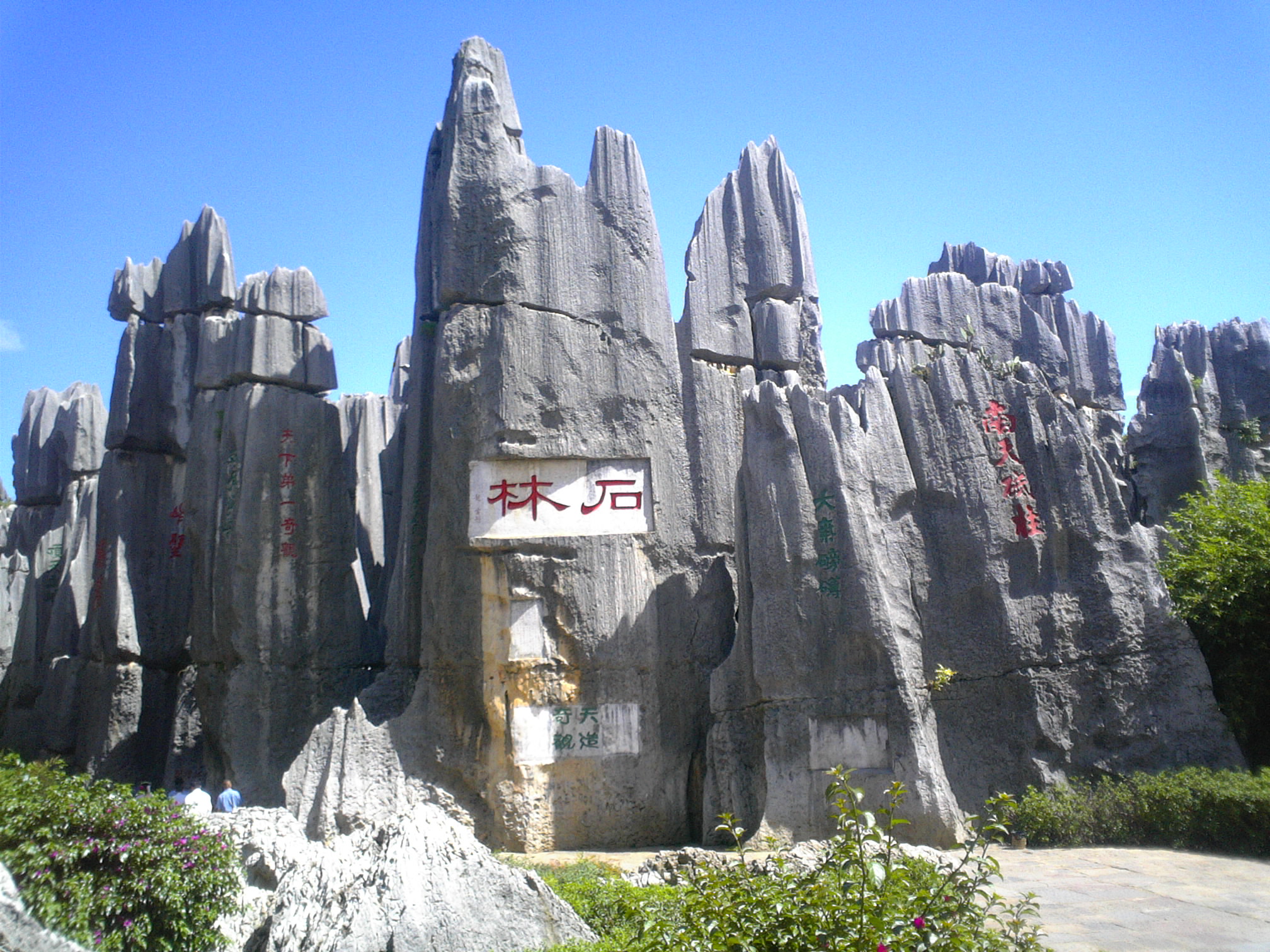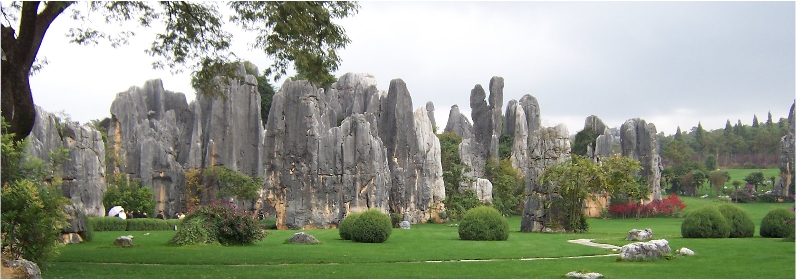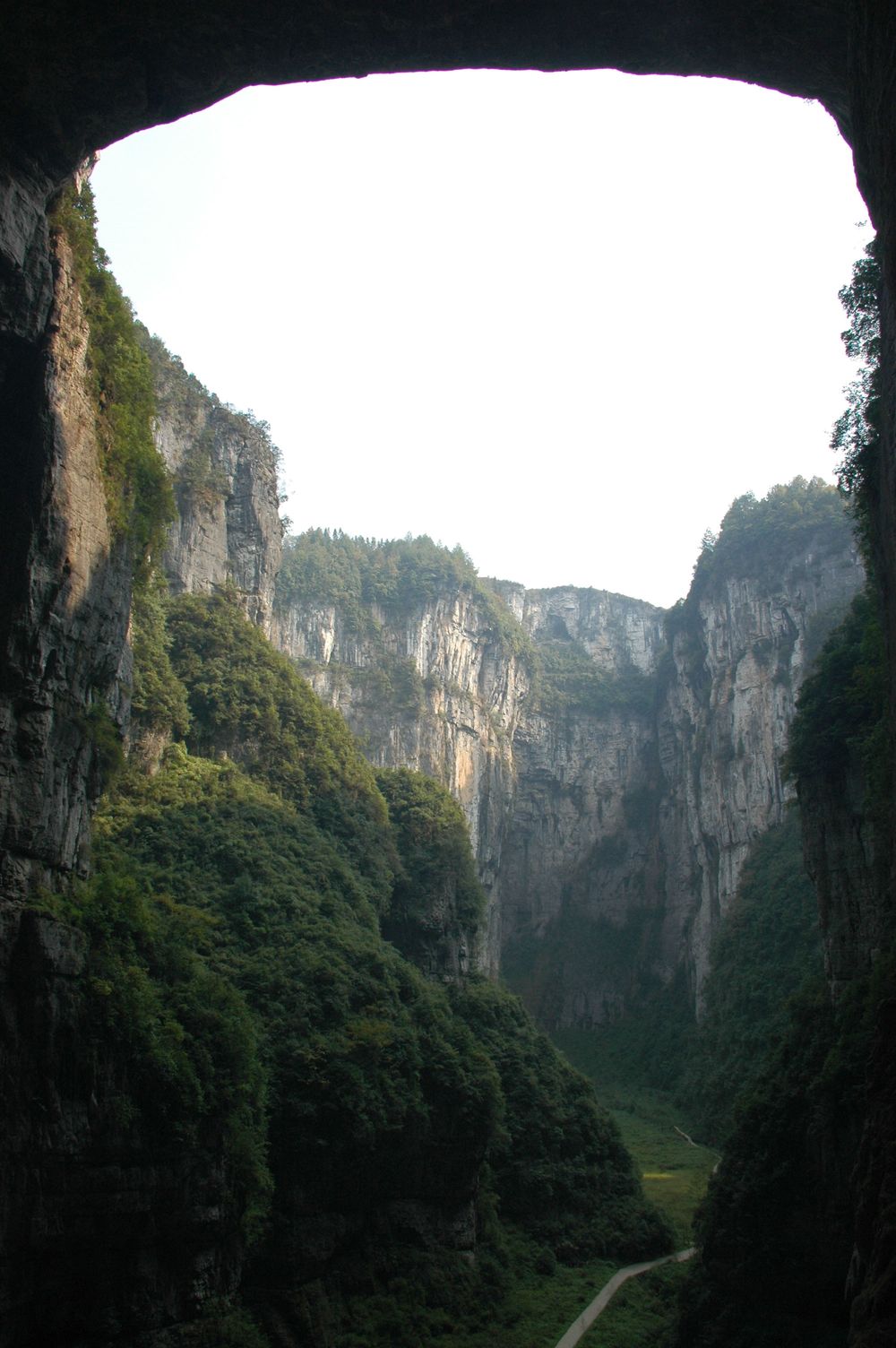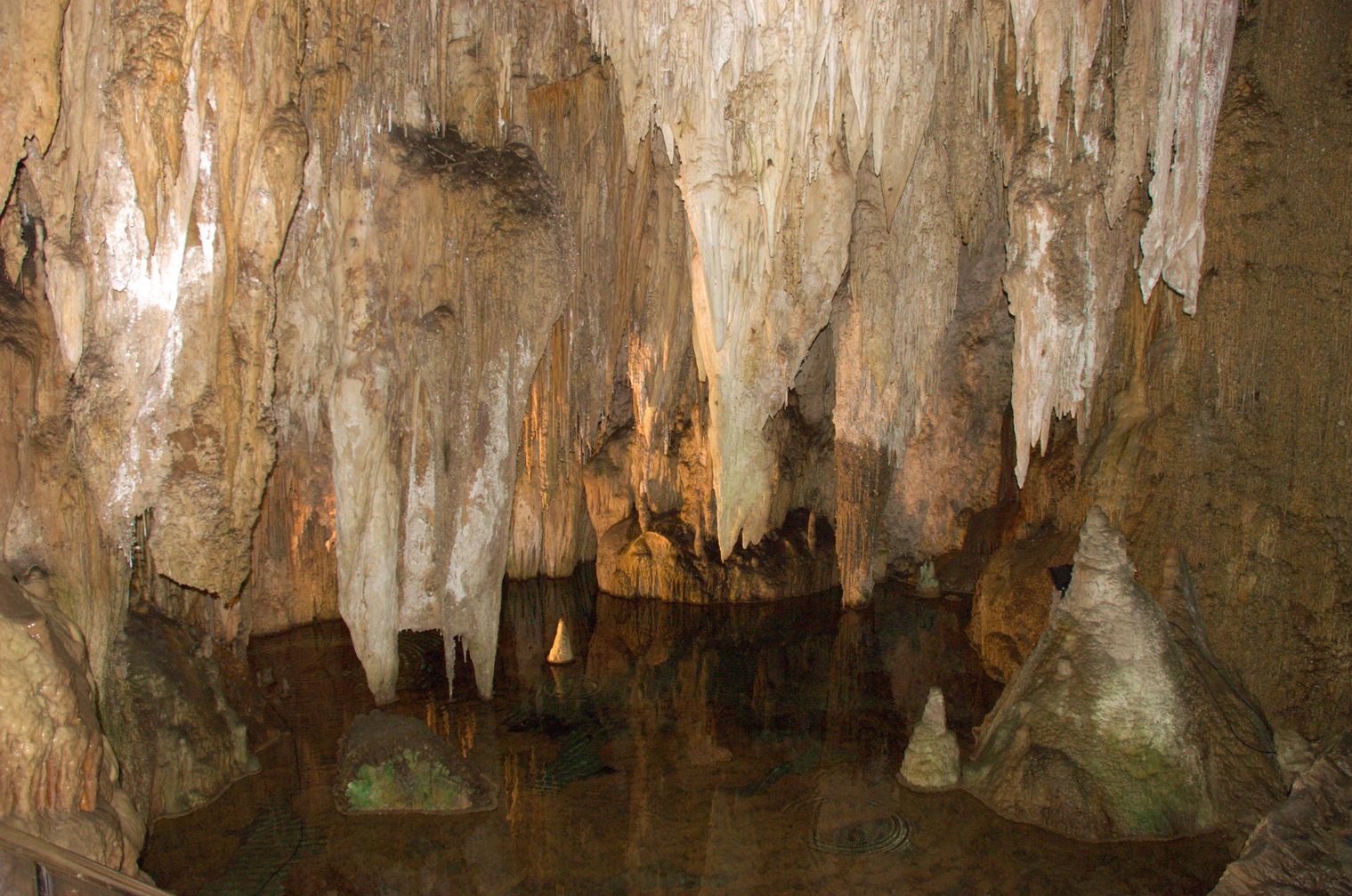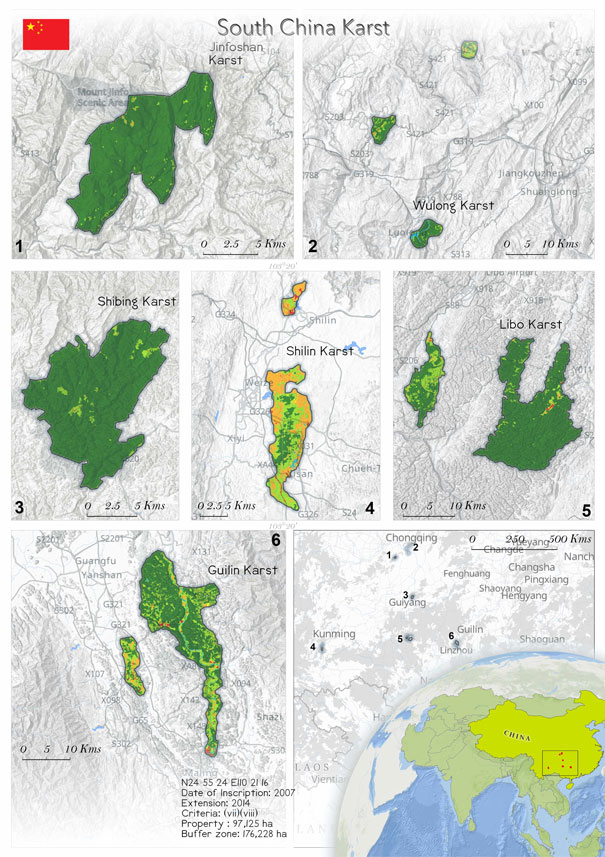
South China Karst (1248)
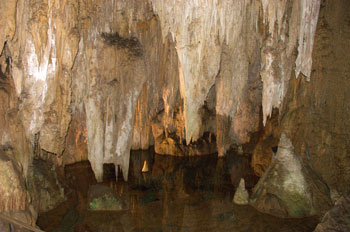 The South China Karst is a World Heritage Site with spectacular and unrivalled karst landscapes. It was inscribed in two phases. This massive serial property is a congregation of seven components, namely Shilin Karst, Libo Karst, Wulong Karst, Guilin Karst, Shibing Karst, Jinfoshan Karst and Huanjiang Karst, the first three being inscribed in 2007 and the other four in 2014.This serial property experiences a mild climate as it is located in the sub-tropical humid monsoon zone, and the average temperature ranges from 14°C to 16°C, with an annual average precipitation of 1000–1300 mm, received mainly during April–September. The climate sustains the various forest types found within the heritage site: deciduous broad-leaf forest, mixed forest, evergreen broad-leaf forest and evergreen needle-leaf forest. The major tree species are Populus, Quercus and Betula spp., Cupressus funebris, Cunninghamia lanceolata, Pinus massoniana and P. yunnanensis. The State Party has been successful in maintaining and protecting the Outstanding Universal Value of the heritage site. The implementation of the Conservation and Management Plan of the Serial Property South China Karst (CMPSCK) and the recommendation of the Protection and Administration Coordinating Committee (PACC) has strengthened the management. The inscription of the property as a World Heritage Site has advertised it in a positive light and attracted lots of tourists. The increased tourism and the infrastructure related to it are a threat to the property.
The South China Karst is a World Heritage Site with spectacular and unrivalled karst landscapes. It was inscribed in two phases. This massive serial property is a congregation of seven components, namely Shilin Karst, Libo Karst, Wulong Karst, Guilin Karst, Shibing Karst, Jinfoshan Karst and Huanjiang Karst, the first three being inscribed in 2007 and the other four in 2014.This serial property experiences a mild climate as it is located in the sub-tropical humid monsoon zone, and the average temperature ranges from 14°C to 16°C, with an annual average precipitation of 1000–1300 mm, received mainly during April–September. The climate sustains the various forest types found within the heritage site: deciduous broad-leaf forest, mixed forest, evergreen broad-leaf forest and evergreen needle-leaf forest. The major tree species are Populus, Quercus and Betula spp., Cupressus funebris, Cunninghamia lanceolata, Pinus massoniana and P. yunnanensis. The State Party has been successful in maintaining and protecting the Outstanding Universal Value of the heritage site. The implementation of the Conservation and Management Plan of the Serial Property South China Karst (CMPSCK) and the recommendation of the Protection and Administration Coordinating Committee (PACC) has strengthened the management. The inscription of the property as a World Heritage Site has advertised it in a positive light and attracted lots of tourists. The increased tourism and the infrastructure related to it are a threat to the property.
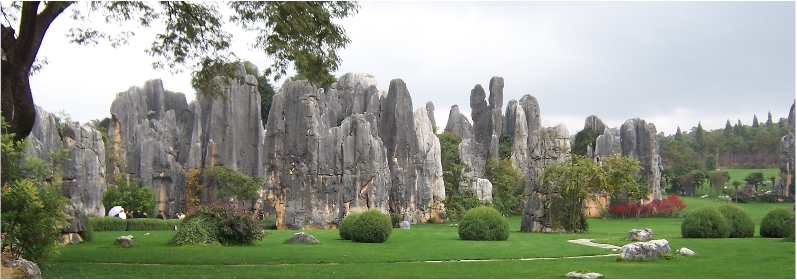 South China Karst is a serial property lying in the Yunnan, Guizhou and Guangxi provinces over an area of a half million square kilometres. The karst landforms of the property are scientifically significant and represents humid tropical to sub-tropical karst formations. The karst landforms include tower karsts, cone karsts, and pinnacle karsts, as well as spectacular bridges, huge caves and gorges. Stone forests of Shilin, cone & tower karts of Libo are considered as a world reference for these karst types. These karst formations give the property its distinctive and picturesque landscape. South China Karst is a congregation of seven individual karst properties falling in four provinces and was inscribed in the UNESCO’s World Natural Heritage Site list in two phases. Three clusters were inscribed in Phase, I in 2007, namely Shilin Karst, Libo Karst and Wulong Karst. Shilin Karst is surrounded by two core zones having a common buffer zone, which is also a UNESCO Geopark. Libo Karst lies in Guizhou Province and has high conical peaks of karst, deep intervening depressions, streams and underground caves. Libo Karst also has two core areas and a common buffer zone. The second phase of inscription took place in 2014 and included more clusters of components in this World Heritage Site. The four clusters were Guilin Karst (Guangxi Province), Shibing Karst (Guizhou Province), Jinfoshan Karst (Chongqing Province) and Huanjiang Karst (Guangxi Province). Karstification at the site has resulted in amazingly diverse surface karst forms, particularly peak-forests, enclosed peaks, cone-shaped peaks, sinkholes and poljes. The peak-forest of Guangxi at Guilin-Yangshuo has the most extraordinary geomorphology. The groundwater runs fast and has a high hydraulic gradient and carrying capacities. The hydrodynamics of South China Karst fluctuates seasonally (Keqiang et al. 2011).
The property has a wonderful biodiversity, with 147 mammal species, 167 amphibian and reptile species, 199 fish species, 398 bird species and 2979 plant species. Nationally endangered and rare species such as Neocheiropteris palmatopedata and Calocedrus macrolepis are also found within the property (Huo et al. 2012). Zhang & Li (2014) found a new spider species complex and reported that there is high diversity among the caves of South China Karst. Ariyawansa et al. (2016) reported two new fungus taxa, Alpestrisphaeria jonesii and Botryosphaeria minutispermatia from the property, in Guizhou Province. Huang et al. (2020) found three new trechine species belonging to the genus Pilosaphaenops, namely P. qianzhii, P. mengzhenae and P. weiguofui.
South China Karst is a serial property lying in the Yunnan, Guizhou and Guangxi provinces over an area of a half million square kilometres. The karst landforms of the property are scientifically significant and represents humid tropical to sub-tropical karst formations. The karst landforms include tower karsts, cone karsts, and pinnacle karsts, as well as spectacular bridges, huge caves and gorges. Stone forests of Shilin, cone & tower karts of Libo are considered as a world reference for these karst types. These karst formations give the property its distinctive and picturesque landscape. South China Karst is a congregation of seven individual karst properties falling in four provinces and was inscribed in the UNESCO’s World Natural Heritage Site list in two phases. Three clusters were inscribed in Phase, I in 2007, namely Shilin Karst, Libo Karst and Wulong Karst. Shilin Karst is surrounded by two core zones having a common buffer zone, which is also a UNESCO Geopark. Libo Karst lies in Guizhou Province and has high conical peaks of karst, deep intervening depressions, streams and underground caves. Libo Karst also has two core areas and a common buffer zone. The second phase of inscription took place in 2014 and included more clusters of components in this World Heritage Site. The four clusters were Guilin Karst (Guangxi Province), Shibing Karst (Guizhou Province), Jinfoshan Karst (Chongqing Province) and Huanjiang Karst (Guangxi Province). Karstification at the site has resulted in amazingly diverse surface karst forms, particularly peak-forests, enclosed peaks, cone-shaped peaks, sinkholes and poljes. The peak-forest of Guangxi at Guilin-Yangshuo has the most extraordinary geomorphology. The groundwater runs fast and has a high hydraulic gradient and carrying capacities. The hydrodynamics of South China Karst fluctuates seasonally (Keqiang et al. 2011).
The property has a wonderful biodiversity, with 147 mammal species, 167 amphibian and reptile species, 199 fish species, 398 bird species and 2979 plant species. Nationally endangered and rare species such as Neocheiropteris palmatopedata and Calocedrus macrolepis are also found within the property (Huo et al. 2012). Zhang & Li (2014) found a new spider species complex and reported that there is high diversity among the caves of South China Karst. Ariyawansa et al. (2016) reported two new fungus taxa, Alpestrisphaeria jonesii and Botryosphaeria minutispermatia from the property, in Guizhou Province. Huang et al. (2020) found three new trechine species belonging to the genus Pilosaphaenops, namely P. qianzhii, P. mengzhenae and P. weiguofui.
Criterion (vii)
The South China Karst World Heritage property includes spectacular karst features and landscapes, which are both exceptional phenomena, and of outstanding aesthetic quality. It includes the stone forests of Shilin, superlative natural phenomena which include the Naigu stone forest occurring on dolomitic limestone and the Suyishan stone forest arising from a lake, the remarkable fengcong and fenglin karsts of Libo, and the Wulong Karst, which includes giant collapse depressions, called Tiankeng, and exceptionally high natural bridges between them, with long stretches of deep unroofed caves. It also includes Guilin, which displays spectacular tower karst and internationally acclaimed fenglin riverine landscapes, Shibing Karst, which has the best known example of subtropical fengcong karst in dolomite, deep gorges and spine-like hills often draped with cloud and mist, and Jinfoshan Karst, which is an isolated island long detached from the Yunnan-Guizhou plateau, surrounded by precipitous cliffs and punctured by ancient caves. Huanjiang Karst provides a natural extension to LiboKarst, contains outstanding fengcong features and is covered in almost pristine monsoon forest. The property’s forest cover and natural vegetation is mainly intact, providing seasonal variation to the landscape and further enhancing the property’s very high aesthetic value. Intact forest cover also provides important habitat for rare and endangered species, and several components have very high biodiversity conservation value.
Criterion (viii)
The South China Karst World Heritage property reveals the complex evolutionary history of one of the world’s most outstanding landscapes. Shilin and Libo are global reference areas for the karst features and landscapes that they exhibit. The stone forests of Shilin developed over 270 million years during four major geological time periods from the Permian to present, illustrating the episodic nature of the evolution of these karst features. Libocontains carbonate outcrops of different ages shaped over millions of years by erosive processes into impressive Fengcong and Fenglin karsts. Libo also contains a combination of numerous tall karst peaks, deep dolines, sinking streams and long river caves. Wulong represents high inland karst plateaus that have experienced considerable uplift, with giant dolines and bridges. Wulong's landscapes contain evidence for the history of one of the world's great river systems, the Yangtze and its tributaries. Huanjiang Karst is an extension of the Libo Karst component. Together the two sites provide an outstanding example of fengcong karst and also preserve and display a rich diversity of surface and underground karst features. Guilin Karst is considered the best known example of continental fenglin and provides a perfect geomorphic expression of the end stage of karst evolution in South China. Guilin is a basin at a relatively low altitude and receives abundant allogenic (rainfed) water from surrounding hills, leading to a fluvial component that aids fenglin development, resulting in fenglin and fengcong karst side-by-side over a large area. Scientific study of karst development in the region has resulted in the generation of the ‘Guilin model’ of fengcong and fenglin karst evolution. Shibing Karst provides a spectacular fengcong landscape, which is also exceptional because it developed in relatively insoluble dolomite rocks. Shibing also contains a range of minor karst features including karren, tufa deposits and caves. Jinfoshan Karst is a unique karst table mountain surrounded by massive towering cliffs. It represents a piece of dissected plateau karst isolated from the Yunnan-Guizhou-Chonqing plateau by deep fluvial incision. An ancient planation surface remains on the summit, with an ancient weathering crust. Beneath the plateau surface are dismembered horizontal cave systems that appear at high altitude on cliff faces. Jinfoshan records the process of dissection of the high elevation karst plateau and contains evidence of the region’s intermittent uplift and karstification since the Cenozoic. It is a superlative type-site of a karst table mountain.
Status
Global warming, along with human activities, is causing a change in climatic parameters of the South China Karst. The increased human pressure triggered rock desertification, and so the property is a major focus of “Returning Farmland to Forest”, an ecological afforestation project of the state party. The study (Zhang et al. 2016) on monitoring problems and solutions of South China Karst revealed that the property, being a serial property, does not have a unified monitoring system but has a series of independent monitoring factors. The monitoring facilities are ill-defined. If the property establishes a good facility and a sound and unified monitoring system, then the management of the site will be strengthened. Analysis of the last 5 years’ State of Conservation (SOC) reports revealed that the Conservation and Management Plan of the Serial Property South China Karst (CMP-SCK) was submitted to the World Heritage Centre in February 2016. The Protection and Administration Coordinating Committee (PACC) handles the overall administration within South China Karst. This step of implementing an integrated management plan has been applauded by the committee as the CMPSCK also complements the individual management plans of each site within the serial property. The committee praised the State Party’s decision to not to go through with the two roads planned for tourism across Shilin Karst as they might be of significant concern to the OUV of the property. Another potential threat to the OUV of the property is the Guiyang-Nanning (GN) high-speed railway, crossing Libo Karst’s buffer zone. The committee has requested an EIA of the GN railway. According to the 2020 IUCN World Heritage Outlook (South China Karst | World Heritage Outlook (iucn. org)), the site has been assessed as “good with some concerns”. According to the assessment, the State Party has been successful in protecting and managing the OUV and geological values of the property. The CMP-SCK is still being implemented, and significant progress is being seen within the property. However, the increased tourism, the infrastructure related to it and the pollution of both underground and surface water catchments are serious threats. However, the seriousness of both these threats varies from site to site as South China Karst is a serial property. Overall, it can be concluded that the inscription of South China Karst in the UNESCO’s World Heritage List has boosted the property’s Outstanding Universal Value and has helped protect and manage the OUVs.
